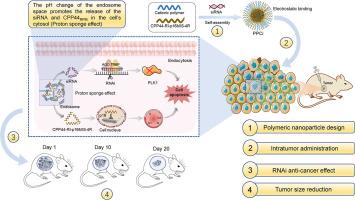用于siRNA传递和协同癌症治疗的肿瘤抑制蛋白激发肽
IF 6.3
3区 综合性期刊
Q1 Multidisciplinary
引用次数: 0
摘要
小干扰RNA (siRNA)在许多重大疾病的治疗中显示出良好的前景。然而,限制siRNA应用的主要原因有两个:内吞效率差和内体逃逸能力弱。因此,开发高效、安全的递送载体一直是RNAi技术研究的一个重要方面。在此,我们设计了一个基于功能化肽的自组装纳米颗粒,将siRNA传递给下调的polo样激酶1 (PLK1)基因,该基因可以抑制肿瘤细胞的G2期。功能多肽由细胞膜穿透肽(CPP44)和p16最小抑制序列(p16MIS)组成。CPP44可有效介导内吞作用,p16MIS可抑制G1期肿瘤生长,并与siPLK1协同促进肿瘤细胞凋亡。体外和体内研究表明,所开发的纳米颗粒具有高水平的沉默效率、抗肿瘤活性和治疗效果。因此,这项研究提供了一种通过同时破坏肿瘤细胞分裂的两个阶段来治疗癌症的新方法。本文章由计算机程序翻译,如有差异,请以英文原文为准。

Tumor suppressor protein-inspired peptide for siRNA delivery and synergistic cancer therapy
Small interfering RNA (siRNA) has shown promising therapeutic prospects in many major diseases. However, two main reasons limit the application of siRNA: poor endocytosis efficiency and weak endosomal escape ability. Therefore, the development of efficient and safe delivery vectors has always been an important study aspect of RNAi technology. Herein, we designed a self-assembled nanoparticle based on functionalized peptides to deliver siRNA to the down-regulated polo-like kinase 1 (PLK1) gene, which can inhibit tumor cells in the G2 phase. The functional polypeptide consists of cell membrane-penetrating peptide (CPP44) and p16 minimal inhibitory sequence (p16MIS). CPP44 can effectively mediate endocytosis, while p16MIS can inhibit tumor growth in the G1 phase and synergistically promote the apoptosis of tumor cells with siPLK1. In vitro and in vivo studies demonstrate that the developed nanoparticle exhibits high levels of silencing efficiency, antitumor activity, and therapeutic efficacy. Consequently, this study provides a novel approach to cancer treatment by simultaneously disrupting two stages of tumor cell division.
求助全文
通过发布文献求助,成功后即可免费获取论文全文。
去求助
来源期刊

Fundamental Research
Multidisciplinary-Multidisciplinary
CiteScore
4.00
自引率
1.60%
发文量
294
审稿时长
79 days
期刊介绍:
 求助内容:
求助内容: 应助结果提醒方式:
应助结果提醒方式:


